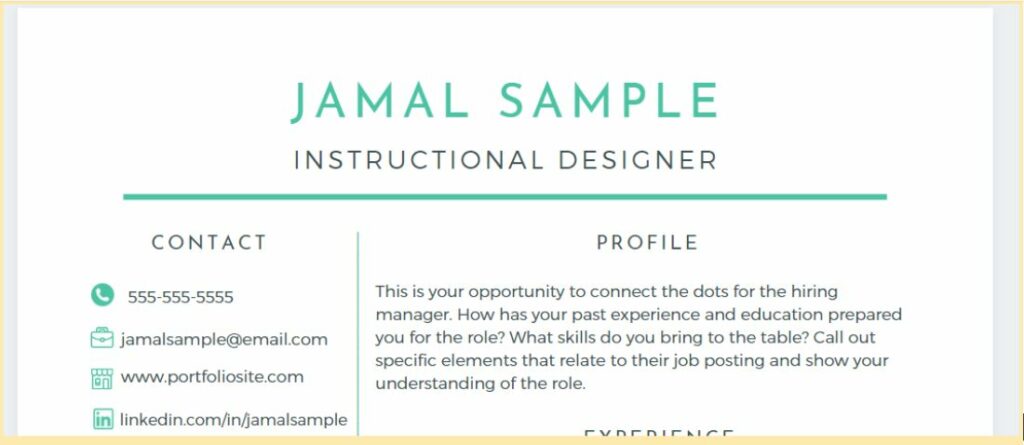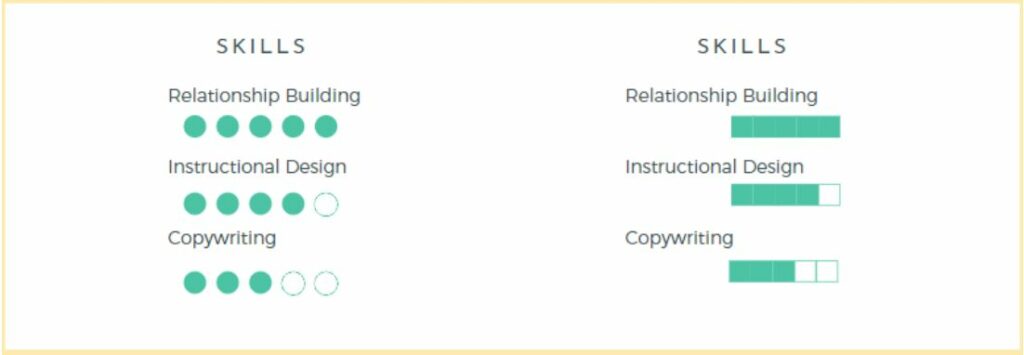4 Creative Resume Ideas For Digital Learning Experts
These creative resume ideas help digital learning experts catch the eye of hiring managers without upsetting the applicant screening AI.

Good resumes are easy to read, convey your work experience, and help hiring managers get to know you. A traditional resume is fine, but it won’t necessarily set you apart from other job applicants. You want to add some polish to an otherwise bland looking document, but you have to strike a balance. Go too modern, and your overly creative resume template can confuse applicant tracking systems.
You’re looking for creative resume ideas that will help you stand out, but in a good way. Fortunately, you don’t have to be a graphic design pro or web design expert to create a unique resume. You can build something in Microsoft Word that supports your job search while expressing your creativity. These creative resume ideas can get you started.
Are creative resumes a good idea?
If you’ve spent your whole career using the same boring resume format you had in college, you might wonder: are creative resumes a good idea? Some worry that creative resume design will cause your application to be rejected by software that doesn’t understand your layout.
Well designed resumes are informative but not boring. In fact, if you want to stand out from the applicant pool, your resume should be both professional and eye-catching. It must include the facts, but should do so in an interesting way.
Most of the advice around resume writing for AI filters also applies to writing for people:
- • write clearly
- • use correct spelling and grammar
- • focus on results
- • include keywords
Remember, AI may do the initial scan, but ultimately a person makes the final decision. So write a resume that you would like to read. The four creative resume ideas listed below won’t confuse an AI, but will give your resume some shine.
1. Get smart with your title
The title on the top of your resume sets expectations. You don’t have to stick to the title you have in your current job. In fact, unless you’re looking for the same role, you probably shouldn’t use that title.
Education and development roles use all kinds of titles. Sometimes the same title means different things in different organizations. There’s no consistent pattern.
Your title often has more to do with the organization you come from than the role you filled. So it’s fine to adjust your title to better fit your actual experience and the role you’re seeking.
Titles made all the difference for one experienced Teammate. Her most recent job title was instructional designer, but her experience told a different story.
She’d designed and built hundreds of courses, worked with SMEs, and had developed robust project management skills. On top of all that, she’d recently gotten a SCRUM certificate. When she revised her resume with the title of “Online Learning Project Manager” she saw better results.
Think about your experience and the role you’re seeking to choose your title.
2. Add some color
The right amount of color can help important details stand out. Consider adding a single accent color to your resume. It won’t help AI programs understand your experience, but it will catch the eye of hiring managers. You can use it for design elements like lines and dividers or as a way to highlight job titles.
Just make sure that whatever you do is consistent and readable. Too many colors can be visually confusing and make your resume look messy. Stay away from light hues that lack contrast with the white page. The color should add a touch of class, not a distraction.

Notice how the example above uses color for the applicant’s name, the divider, and the icons that mark the contact information. You don’t need expert-level design skills to add a bit of color to your resume. Remember, when it comes to color, less is more.
3. Visualize your skills
Every resume should include a skill section. Listing your skills is good. Showing your level of expertise is even better.
Include simple visualizations to help employers understand your competence at a glance. Below are two examples of this in action.

Each example above uses simple shapes to show level of experience. Anything more complex than a square can look gimmicky. So avoid stars, fancy icons, or other complex images.
Keep the text above or beside the visualization. Embedding the text in the image means applicant tracking systems won’t be able to read it. The graphic should support the text, not distract from it.
4. Quote Employers and Colleagues
Your resume is basically just you bragging about yourself. Your potential employer knows that. Adding someone else’s perspective can make an impact. When you add testimonials from employers or colleagues, hiring managers don’t have to rely on your word alone.
A good resume quote is:
- • Clear and concise, no more than a sentence or two
- • Uses specific examples or job-related keywords
- • Stands alone, can be understood without context
- • Is attributable, you mention who said it and their relationship to you
Your LinkedIn recommendations are a great place to start looking for good resume quotes. If you don’t have any, reach out to colleagues and former bosses. Testimonials are good for your LinkedIn profile and your resume.
Quotes are an optional extra. You can add one or two if you have the space, but don’t crowd your resume just to fit quotes on the page.
Pro tips for resume submission
Before you submit your resume, proofread carefully. Spelling and grammar matter. Small errors can make you seem less professional.
Make sure you’ve included relevant links and social media profiles where appropriate. If you have a professional portfolio, link to it.
Unless the employer asks for something else, always send your resume in PDF format. It’s the only way to make sure you preserve your resume formatting.
For more creative resume ideas
Get more creative resume ideas and resume writing tips in our Guide to Resume Writing for Digital Learning Professionals. When you’re ready to find your next role in digital learning, contact Teamed. We connect digital learning experts with the businesses, schools, and colleges that need their skills.




